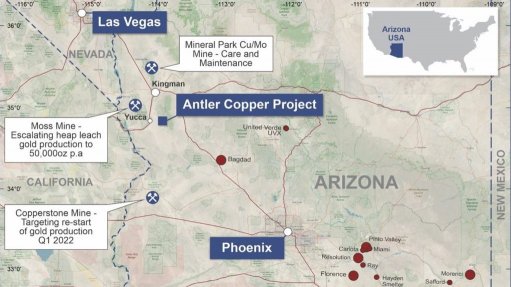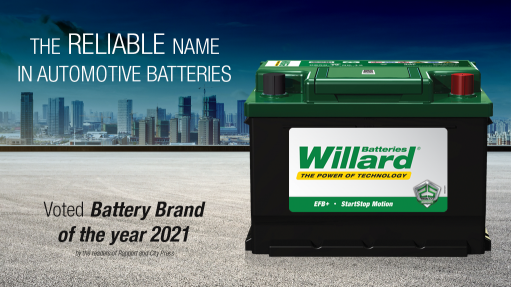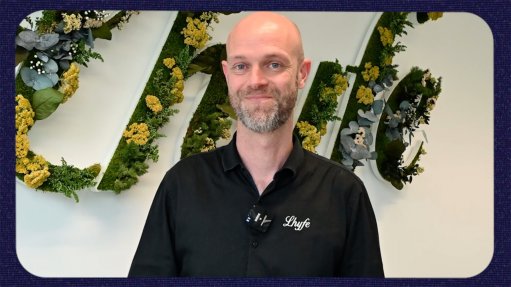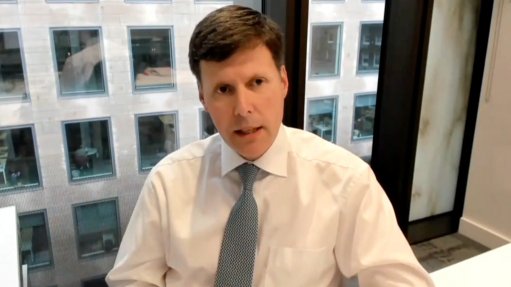300-plus vehicle fleets assessed for cleaner, safer mine mobility in five regions – ICMM

International Council on Mining and Metals’ Sarah Bell interviewed by Mining Weekly’s Martin Creamer. Video: Darlene Creamer.
JOHANNESBURG (miningweekly.com) – As part of the cleaner, safer vehicles initiative of the International Council on Mining and Metals (ICMM), more than 300 vehicle fleets have been assessed for cleaner, safer mobility on more than 300 mines in five regions globally, ICMM health, safety and product stewardship director Sarah Bell reported on Tuesday.
Bell was speaking to Mining Weekly in a Zoom interview on the ICMM's Innovation for Cleaner, Safer Vehicles initiative, which brings 28 of the world's leading mining and metals companies and 19 original equipment manufacturers (OEMs) together to collaborate in a non-competitive space, to accelerate the development of a new generation of mining vehicles – and improve existing ones. (Also watch attached Creamer Media video.)
ICMM membership makes up around a third of the global mining sector, which accounts for about 650 assets in over 50 countries.
The initiative is CEO-led and it has three specific ambitions that have been designed to address three of the most critical safety, health and environmental performance issues within the global mining sector.
The first ambition is about introducing greenhouse gas emission-free surface mining vehicles by 2040 – that is, decarbonising the mining fleet. The second is about minimising the operational impact of diesel exhausts underground by 2025, and the third is about making vehicle-collision avoidance technology available to mining companies by 2025.
The first ambition recognises that the mining industry is currently a large greenhouse gas emitter and that mining vehicles account for around 50%, and sometimes up to 80%, of Scope 1 emissions – direct greenhouse gas emissions – on mine sites.
The second ambition recognises that almost all underground mining equipment is diesel driven and diesel particulate matter (DPM) has been classified as a carcinogen by the World Health Organisation. Exposure to DPM emissions has been linked to negative health effects. Most interesting about the second ambition is that there are many solutions already out there now to help reduce DPM underground and so this initiative is working to raise awareness and promote the existing adoption of these technologies today, with the support of OEM partners to ensure their successful implementation.
The third ambition recognises that transport and mobile equipment accidents account for, on average, 30% of the yearly fatalities of the members of ICMM, which recognises also that vehicle-collision avoidance technology is not a silver bullet and that members also need to ensure that they invoke upgrading discipline as an absolute prerequisite.
In the interview, Bell responded to questions, including one on the progress that ICMM has made so far in realising the three ambitions of the Innovation for Cleaner Safer Vehicles initiative, which is ultimately there to save lives and contribute towards decarbonisation.
The initiative is now two-and-a-half years old, in an industry known for being action orientated, which points to the need for challenging conversations to align the industry to what really needs to be done to save lives and become emission free. Building and maintaining trust with such a large group of stakeholders has, however, proved challenging, and achieving sustainable ownership within a collaboration model has been found to require considerable time, even though everything the ICMM does is CEO-aligned.
Mining Weekly: What is significant about the Innovation for Cleaner, Safer Vehicles initiative? How is it different to what the industry was doing previously?
Bell: There are two key things. Firstly, this is CEO-led through a co-chair governance structure from both participating mining companies and also the OEMs. This demonstrates just how important this initiative is to ICMM's council of 28 CEOs, and also helps to accelerate the pace of change when you have such leadership engaged in this change programme. The co-chair governance structure involves three of our mining company CEOs. It is chaired by Mike Henry from BHP, our most recent chair following the retirement of Nick Holland from Gold Fields. Then we have two other mining company representatives, Mark Cutifani from Anglo American and also Eduardo Bartolomeo from Vale. We then have three OEM CEOs and/or executives from the OEM side, which is made up of Denise Johnson from Caterpillar, Max Moriyama from Komatsu and Henrik Ager from Sandvik. This is a really important group, who are providing the initiative with strategic guidance and advice and, even beyond that, they’re tabling any recommendations and decisions that need to be taken back up to our broader group of 28 CEOs. The second thing that makes this initiative so significant is that it represents critical mass of the industry. This reinforces both the convening power of ICMM to help drive change and to promote what we're doing more broadly, beyond our membership. More importantly, it helps the OEMs to build the widespread confidence that they need to accelerate the level of innovation investment to scale up these commercial solutions. Simply put, what we’re trying to do here is to break down silos and to generate one voice. For many years the OEMs have been receiving mixed signals from mining companies and the reality is that you can’t be investing that amount of research and development (R&D) into many different solutions that may or may not be used. This initiative provides safe space for the OEMs and mining companies to work openly together to think about those areas where we may develop solutions and overcome those silos. That ultimately helps the OEMs to better direct their R&D effort. Another way that we break down the silos within the industry is by looking to either partner with or work really closely with other global initiatives out there. For example, we have a technical partner in the earthmoving equipment safety roundtable, which is based in Australia, for our vehicle interaction group, and we also partner with a number of innovation organisations in Canada, which help us particularly with the greenhouse gas question, but also on the DPM workstream. This reinforces what is also unique about the initiative is that we are not focused on developing technical solutions and we do remain technology agnostic because we are operating under anti-trust laws here. Instead, what we look to do is set the change framework, drive that change and develop guiding principles to disrupt the status quo. More importantly, within our collaboration model, we’re convening the parties, we’re motivating action and then we promote the outcomes. What we do there is to collaborate with organisations that do have the mandate to develop and pilot technical solutions that will result in the ambitions being achieved. They are set up to establish commercial and legal agreements in the way that ICMM is not right now.
Mining Weekly: What progress has been made so far?
Bell: I’ve been part of this initiative from the beginning, when it was launched by our CEOs in October 2018. The best way to break down progress is over the first three years, the first phase of the initiative. In 2019, we focussed on bringing these groups together, building trust in relationship. We established three working groups, one for each ambition set, and they focused on creating a common language to help understand the pathway towards those ambitions. Then we spent a lot of time defining functional, technical requirements that the OEMs in particular needed us to align on to help them move forward. In 2020, we used the creation of that common language to form critical change tools for the industry and they are now housed on our Innovation for Cleaner, Safer Vehicles initiative knowledge hub, which is on ICMM.com. This helps to facilitate knowledge sharing amongst the industry and particularly beyond ICMM. We want everyone beyond the membership to take these up and to start a really critical dialogue with their leaders to not only change, but to transform their fleet towards cleaner, safer vehicles. We also established a series of maturity frameworks and these helped mining companies, not just our members, all mining companies to map their current and future state, motivate action and then measure progress against the ambitions that have been published. The intention here again is to help stimulate leadership conversations, hopefully build some decision-making abilities and then drive real action. The most important progress that’s been made in 2021 is that our members have taken these change tools, they’ve started in strategic leadership dialogues within their organisations and they assessed where they currently were and where they want to be against these maturity frameworks. This resulted in more than 300 vehicle fleets being assessed in over 300 assets across the membership, in five regions globally. This is really, really important because it became a measurable aid for our council to see just how far we’ve got to go and also reaffirms our commitment to the ambitions. And, more importantly, as we move into the next phase, it helps to shape the next strategy cycle.
Mining Weekly: What are the main challenges in reaching these ambitions?
Bell: I’ll start with the largest challenge. I’ll start there because it’s also the most rewarding to respond to over the last three years, and that’s been about building and maintaining trust with such a large group of stakeholders, and the initial steps to manage this challenge by setting a leadership tone that generally embraces diversity is a clean way of earning trust within the team. It’s well known that working with people that are different to us challenges our thinking and we need disruption here and this enables innovation. So, this will also allow us hopefully to have better outcomes. We need this, because when we cut through this initiative as a strategic process, we’re ultimately here to save lives and contribute towards decarbonisation. The sooner we can have more challenging conversations with each other and get aligned on what really needs to be done, the sooner we can achieve our ambitions. The second challenge is that it takes time to bring sustainable ownership within a collaboration model. This initiative is now two-and-a-half years old and this is tough because in the mining industry, we’re very action orientated, right. We like to get on with things and so we need to be comfortable in setting the problem, then being clear on the pathway there, providing the tools that we have done, and then allowing the mining companies and the OEMs to get on with the action that they need to take. Other points in terms of challenge are that it’s really clear that each mining company operates within various constraints, different jurisdictions, different budgets, different operational capital constraints, and so we need to be really clear that we are setting and providing different options for the mining companies to take. If I give you a few examples, more specifically, of some of the challenges here, diesel machines are much cheaper to purchase but more expensive to operate, compared with the currently available zero-emissions alternatives. So, the transition to cleaner underground engines in the mining industry doesn’t only require innovation in the technology itself, it will also require innovation in the business models that are established. One example of that is around Epiroc and the batteries service model that they are running, which helps mining companies to manage the capex versus opex dilemma that they’re facing. Another example that I’d give you is around developing batteries at scale to surface fleet. We’ve seen a lot of interest. I think this is a really building story here. Whether or not you are going down a pathway of battery electric or hydrogen fuel cells or trolley assist, we talk about all of those different options and we talk about them because we recognise we have different mining operations that will need all of those different solutions to work. So, we work together, not only on the machine itself, but also ensuring that we are focused on the infrastructural enabling environment around the truck, which asks what is meant by battery charging and how do we have flexible battery charging. One example that’s leading that challenge externally to us is an innovation called the charge-on initiative. It’s a really exciting initiative, I think, and that looks to help understand the challenge of making sure about new cleaner vehicles aren't just being developed but they are also being developed in tandem with the supporting infrastructure at the same time. It’s no use having a nice battery electric or hydrogen fuel cell truck ready to go but the supporting infrastructure has not been readied, makes very difficult for the OEMs to develop that fleet at scale.
Mining Weekly: What have the key learnings been so far?
Bell: So far, that’s a very good way to put it. I think the first one is to create a safe space for dialogue. We’re very clear on our boundaries. We convene, we motivate and we promote the outcomes, and we do this by operating in an anti-trust environment. That means that we need to remain technology agnostic, and you can imagine that that’s a challenge. You’ve got a group of technical mining experts who want to get into that detail, and we can, but only to a certain point. So, we need to be able to provide a convening space where they might come together in another way to talk about those things. They can at least meet each other through this initiative and then go off and have commercial and legal conversations, if they’d like to. The second big learning is that communication is key. We need to be able to pitch key messages at different decision-making levels, whether that’s CEOs, site management or the technical practitioners on the ground. The same message needs to cut though in different ways. Another critical one would be to spend time on the problem. Get comfortable staying with the problem that you're trying to solve and be very clear on how your initiative differs from the other ones out there. That’s really important again because there are many of these initiatives out there and they are all really important. Again, the OEMs do tell us that we need to be really clear on how these different initiatives talk to each other, otherwise you potentially get back to this point where the OEMs are saying 'you're not co-ordinated', and asking, 'what’s going on', and that's what we work really hard on. The most critical thing is to have practical, tangible actions along the way. We're the staging gates, if you like, so our participants can see that we're making progress along the way. We need to keep people motivated. The last one that we’ve learnt so far is being really clear on the roles within your governance structure, if you’re setting up a supply chain collaboration, like this one, and I think we need more of them to solve other industry challenges. This initiative is only one of many that are needed, I think. The OEMs know that everything we do, every decision to be taken, is first discussed with them and shared with them before we take it to the CEOs, and that’s a really critical learning for us and I would say any other initiative that wants to get out there to solve any other collaborative supply chain challenge.
Mining Weekly: And what's next?
Bell: We’ve had our first three years. We’re in the last year of our three year strategy cycle now, and we're currently developing our next one with our council of CEOs. What’s really great to hear is that the Innovation for Cleaner, Safer Vehicles initiative remains strategically significant for our CEOs, so it will continue. Just reflecting on the first phase of the initiative, which is focused on building awareness, it’s also built these three critical foundations for what we do next. Firstly, we build trust in the collaboration, we’ve reached alignment on the pathways forward, and more recently now we've created this aggregated industry first view and our members current and future positions at over 300 assets, to help them achieve the ambitions set. These were presented to our CEOs in May and they helped to motivate further action and they, more importantly, have helped to shape the next phase of this initiative. Now that we’ve got these foundations in place, we’ve started to develop the next phase, which will start in 2022. The Innovation for Cleaner, Safer Vehicles initiative now needs to shift its focus from building awareness and trust to getting on with adoption readiness and implementation, which is easier said than done. But in practice what this means for us is that we need to enhance our collaboration model to engage an even more diverse range of innovators, particularly the original technology integrators, the companies that will help us better understand what the infrastructure requirements look like around the machine, for example. We need more people because that will continue to strategically challenge our thinking. We need to keep this disruption going and enable our shift in focus from what has been more awareness building to taking action. To fully enable the ambitions to be met, we need to focus beyond the machine while simultaneously supporting the planning for mine-site design and infrastructure to help operations to deploy these new technologies. We’ve more recently been spending a lot of time on even some of the software initiatives that are out there that would help the mine planners to start to take more strategic action. This initiative has resulted in a really significant and positive shift in collective sentiment, and that’s really important, again, for the OEMs. We know that these ambitions can be met by sparking leadership dialogue and that they will result in subsequent change. Beyond the Innovation for Cleaner, Safer Vehicles initiative, there does remain more work to do more broadly, to help industry transform. We would see the initiative as a blueprint to help accelerate other disrupting and innovative partnerships that the mining sector will need to tackle along the supply chain.
Comments
Press Office
Announcements
What's On
Subscribe to improve your user experience...
Option 1 (equivalent of R125 a month):
Receive a weekly copy of Creamer Media's Engineering News & Mining Weekly magazine
(print copy for those in South Africa and e-magazine for those outside of South Africa)
Receive daily email newsletters
Access to full search results
Access archive of magazine back copies
Access to Projects in Progress
Access to ONE Research Report of your choice in PDF format
Option 2 (equivalent of R375 a month):
All benefits from Option 1
PLUS
Access to Creamer Media's Research Channel Africa for ALL Research Reports, in PDF format, on various industrial and mining sectors
including Electricity; Water; Energy Transition; Hydrogen; Roads, Rail and Ports; Coal; Gold; Platinum; Battery Metals; etc.
Already a subscriber?
Forgotten your password?
Receive weekly copy of Creamer Media's Engineering News & Mining Weekly magazine (print copy for those in South Africa and e-magazine for those outside of South Africa)
➕
Recieve daily email newsletters
➕
Access to full search results
➕
Access archive of magazine back copies
➕
Access to Projects in Progress
➕
Access to ONE Research Report of your choice in PDF format
RESEARCH CHANNEL AFRICA
R4500 (equivalent of R375 a month)
SUBSCRIBEAll benefits from Option 1
➕
Access to Creamer Media's Research Channel Africa for ALL Research Reports on various industrial and mining sectors, in PDF format, including on:
Electricity
➕
Water
➕
Energy Transition
➕
Hydrogen
➕
Roads, Rail and Ports
➕
Coal
➕
Gold
➕
Platinum
➕
Battery Metals
➕
etc.
Receive all benefits from Option 1 or Option 2 delivered to numerous people at your company
➕
Multiple User names and Passwords for simultaneous log-ins
➕
Intranet integration access to all in your organisation



















